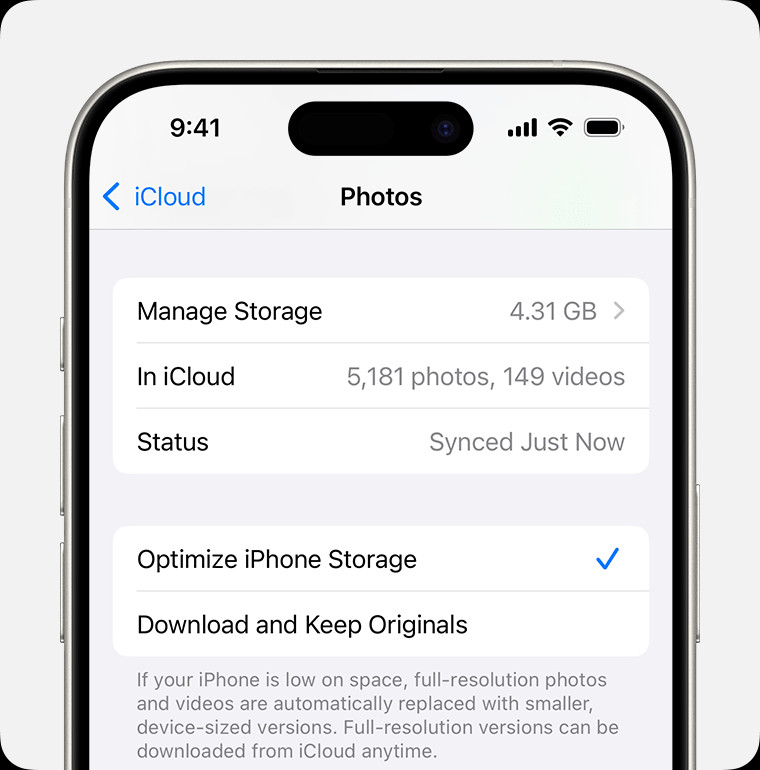iCloud Photos is an invaluable service that works seamlessly with the Photos app across your Apple ecosystem. It ensures your precious photo and video memories are not only safely stored in iCloud but also kept up to date on all your devices, including iPhone, iPad, Apple Vision Pro, Mac, Apple TV, and even accessible via iCloud.com. Losing photos can be heartbreaking, and understanding How To Back Up Photos To Icloud is the first step in safeguarding these irreplaceable moments. This guide will provide you with a comprehensive understanding of iCloud Photos and how to effectively use it to back up and manage your photo library.
Understanding How iCloud Photo Backup Works
iCloud Photos operates in the background to automatically upload every new photo and video you capture directly to iCloud. This means the moment you snap a picture on your iPhone, it’s securely being backed up. The beauty of this system is its accessibility; your entire photo library becomes available from any device where you are logged in with your Apple ID and iCloud Photos is enabled. Simply open the Photos app, and your memories are there, organized and ready to be relived.
More than just storage, iCloud Photos offers synchronization. Any edits you make, albums you create, or even deletions you perform on one device are mirrored across all your other devices. This ensures consistency and saves you the hassle of managing multiple libraries. Your photos and videos are intelligently organized into Years, Months, Days, and All Photos views, making navigation intuitive. Features like Memories and People & Pets recognition are also synced, ensuring a unified and personalized photo experience across your Apple world.
Crucially, iCloud Photos stores your photos and videos in their original formats and at full resolution. Whether you shoot in HEIF, JPEG, RAW, PNG, GIF, TIFF, HEVC, or MP4, or utilize special formats like slo-mo, time-lapse, 4K videos, and Live Photos, iCloud preserves the quality. Apple utilizes efficient compression technologies like HEIF and HEVC to manage storage space without compromising visual fidelity. The initial synchronization time will depend on your internet speed and the size of your library, but once set up, the process is largely seamless and automatic.
 iCloud Photos keeps your photos and videos up to date across devices
iCloud Photos keeps your photos and videos up to date across devices
Step-by-Step Guide: Turning on iCloud Photo Backup
Before you can enjoy the benefits of iCloud Photos, you need to activate it on each of your Apple devices. Ensure you are signed in to iCloud with the same Apple ID across all devices for seamless synchronization. Here’s how to turn on photo backup to iCloud on different Apple devices:
Enabling iCloud Photo Backup on iPhone, iPad, or Apple Vision Pro
-
Launch the Settings app from your Home screen.
-
Tap on [Your Name] at the top of the Settings menu.
-
Select iCloud.
-
Tap on Photos.
-
Toggle the switch next to Sync this [Device] to the ON position (it will turn green).
 iCloud Photos keeps your photos and videos up to date across devices
iCloud Photos keeps your photos and videos up to date across devices
Enabling iCloud Photo Backup on Mac
- Click the Apple menu () in the top-left corner of your screen.
- Choose System Settings (or System Preferences depending on your macOS version).
- Click on [Your Name] (Apple ID).
- Select iCloud from the sidebar.
- Ensure Photos is selected in the iCloud service list.
- Click the switch next to Sync this Mac to enable iCloud Photos.
Enabling iCloud Photo Backup on Apple TV 4K and Apple TV HD
- Go to Settings on your Apple TV home screen.
- Select Users and Accounts.
- Choose iCloud.
- Turn iCloud Photos to On.
Setting up iCloud Photo Backup on a Windows PC
While iCloud Photos is primarily designed for the Apple ecosystem, you can also access your iCloud Photo Library on a Windows PC using the iCloud for Windows application.
Learn how to set up and use iCloud Photos on your PC for detailed instructions.
Understanding Edits and Deletions in iCloud Photos
iCloud Photos is not just about backup; it’s about maintaining a unified photo library. This means that actions you take on one device are reflected across all connected devices.
How Edits Sync Across Devices
When you edit a photo or video within the Photos app on your iPhone, iPad, or Mac, these edits are non-destructive and automatically synced to iCloud. This ensures that the enhanced version of your photo is available on all your devices, including your Apple TV. Whether you crop, adjust colors, or apply filters, your creative changes are universally applied. The original, unedited photo is always safely stored in iCloud, allowing you to revert to the original at any time if needed.
How Deletions Sync Across Devices
Similarly, when you delete photos or videos from one device, they are deleted from iCloud and consequently from all devices using iCloud Photos. This is a powerful synchronization feature, but it also requires caution. Accidental deletions are recoverable; photos and videos are moved to a “Recently Deleted” album where they remain for 30 days before permanent deletion. This grace period provides a safety net for accidental removals.
Downloading Photos and Videos from iCloud
While iCloud Photos keeps your library readily accessible, there might be times when you need to download copies of your photos and videos. Since photos in iCloud Photos are not duplicated in your iCloud Backup, it’s wise to maintain separate backups. Here are ways to download your photos and videos:
Downloading via iCloud.com
-
Go to iCloud.com in a web browser and sign in with your Apple ID.
-
Click on the Photos app icon.
-
Select the photos and videos you wish to download. You can select multiple items by holding down the Command key (on Mac) or Control key (on Windows).
-
Click the download button (cloud icon with a downward arrow) in the top-right corner. For more options, click the More button (three dots).
-
Choose your download preferences:
- Most Compatible: Downloads in JPEG and H.264 format, suitable for most devices.
- Unmodified Original: Downloads the original file as captured or imported, preserving the original format and quality.
-
Click Download.
Downloading Photos and Videos to iPhone, iPad, or Apple Vision Pro
-
Open the Photos app.
-
Select the photos or videos you want to download.
-
Tap the Share button (box with an upward arrow).
-
Choose AirDrop and select the device you want to share to for direct transfer to another Apple device. For saving to your device, choose Save Image or Save Video. For large transfers, consider importing directly to a computer as described below.
Downloading Photos and Videos to Mac
- Open the Photos app on your Mac.
- Select the photos and videos you want to download.
- Drag the selected items directly to your desktop or a folder in Finder. Alternatively, Control-click and choose Share > AirDrop to share to another Apple device. You can also choose Export to save in specific formats or locations.
Managing iCloud Storage for Photos
iCloud Photos utilizes your iCloud storage allocation. Understanding and managing your storage is crucial for continuous photo backup to iCloud.
iCloud Storage Basics and Upgrading
Every Apple ID comes with 5GB of free iCloud storage. For extensive photo and video libraries, this might be insufficient. Apple offers iCloud+, a subscription service that provides increased storage and additional premium features.
Learn how to upgrade to iCloud+ to explore available storage plans and benefits.
Checking iCloud Storage Recommendations
In iOS 17, iPadOS 17, and later, Apple provides helpful recommendations within your iCloud settings to manage storage.
Learn how to make more space by reviewing these suggestions, which may include identifying and deleting unnecessary photos or videos.
Optimize Storage vs. Download Originals
iCloud Photos offers two storage optimization settings:
- Optimize Storage (Space Saver): This is ideal for devices with limited storage. Original, high-resolution photos and videos are stored in iCloud, while space-saving, optimized versions are kept on your device. Originals are downloaded on demand when you need them, provided you have a Wi-Fi or cellular connection.
- Download Originals (Storage Intensive): This setting keeps full-resolution originals both in iCloud and on your device. Choose this if you prioritize having immediate access to original quality photos and have ample storage on your device.
You can choose your preferred setting based on your device storage capacity and access needs.
Changing Storage Optimization Settings:
On iPhone, iPad, or Apple Vision Pro:
- Go to Settings > [Your Name] > iCloud > Photos.
- Choose either Optimize [Device] Storage or Download and Keep Originals.
On Mac:
- Open the Photos app and click Photos in the menu bar.
- Select Settings (or Preferences).
- Go to the iCloud tab and choose your desired storage setting.
Pausing iCloud Photo Uploads
In situations where you have a slow internet connection or are on a metered data plan, you might want to temporarily pause iCloud Photo uploads.
How to Pause Uploads
- On iPhone, iPad, or Apple Vision Pro: Open the Photos app, scroll to the bottom of the Library tab and tap Pause. Alternatively, tap your profile button in Photos and tap Pause. In older iOS versions, navigate to the All Photos album within the Library tab and scroll to the bottom to find the Pause option.
- On Mac: Open the Photos app, select Library in the sidebar, and then All Photos in the toolbar tabs. Scroll to the bottom of your photos and click Pause.
The pause function temporarily halts uploads for one day, giving you control over data usage and bandwidth.
Conclusion
Understanding how to back up photos to iCloud is essential for any Apple user invested in preserving their visual memories. iCloud Photos offers a robust, seamless, and user-friendly solution for backing up, synchronizing, and accessing your photo and video library across your Apple devices. By following this comprehensive guide, you can confidently set up and manage iCloud Photos to ensure your precious moments are safe, accessible, and always with you. Remember to regularly manage your iCloud storage and choose the settings that best suit your needs to enjoy the full benefits of iCloud Photos.
